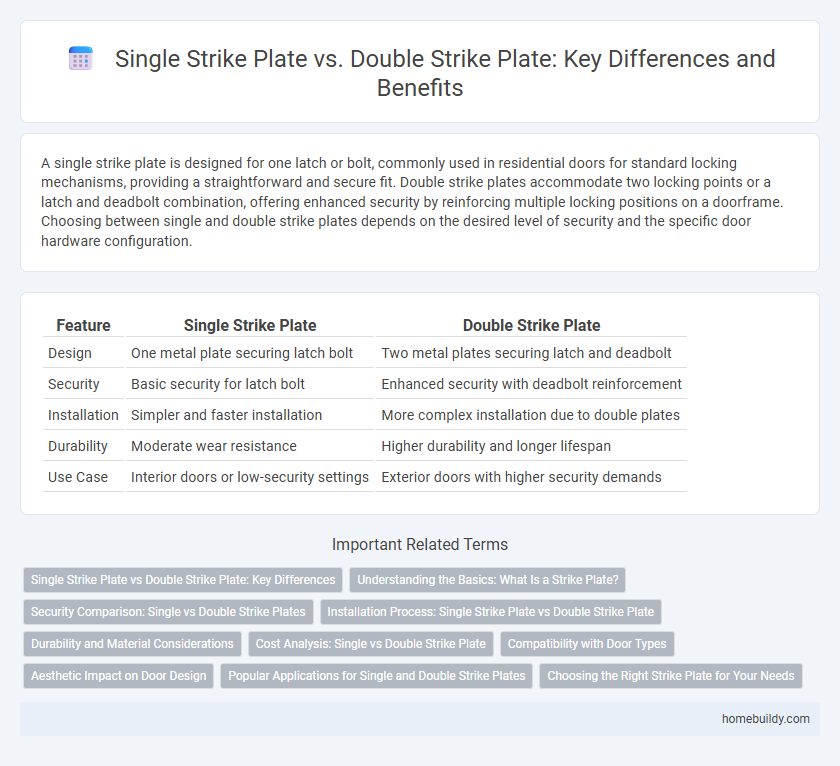A single strike plate is designed for one latch or bolt, commonly used in residential doors for standard locking mechanisms, providing a straightforward and secure fit. Double strike plates accommodate two locking points or a latch and deadbolt combination, offering enhanced security by reinforcing multiple locking positions on a doorframe. Choosing between single and double strike plates depends on the desired level of security and the specific door hardware configuration.
Table of Comparison
| Feature | Single Strike Plate | Double Strike Plate |
|---|---|---|
| Design | One metal plate securing latch bolt | Two metal plates securing latch and deadbolt |
| Security | Basic security for latch bolt | Enhanced security with deadbolt reinforcement |
| Installation | Simpler and faster installation | More complex installation due to double plates |
| Durability | Moderate wear resistance | Higher durability and longer lifespan |
| Use Case | Interior doors or low-security settings | Exterior doors with higher security demands |
Single Strike Plate vs Double Strike Plate: Key Differences
Single strike plates feature one recessed area to catch the latch, providing a straightforward installation suitable for standard door frames. Double strike plates have two recessed areas designed to accommodate both the latch bolt and deadbolt, offering enhanced security and compatibility with doors featuring multiple locking mechanisms. Selecting between single and double strike plates depends on the door's locking system configuration and security requirements.
Understanding the Basics: What Is a Strike Plate?
A strike plate is a metal plate affixed to a door frame that reinforces the area where the latch or bolt enters, enhancing security and door alignment. Single strike plates accommodate one latch bolt, common in standard door locks, while double strike plates feature two openings to support both latch bolt and deadbolt, providing extra strength and security. Choosing between single and double strike plates depends on the lock type and desired protection level for the door.
Security Comparison: Single vs Double Strike Plates
Single strike plates offer basic security by reinforcing the door frame against forced entry, but double strike plates significantly enhance protection by distributing the impact force across two points, reducing the risk of door frame splitting. The double strike plate's design improves resistance to kick-ins and prying attacks, making it ideal for high-security applications. Choosing double strike plates over single ones provides a stronger, more durable locking mechanism essential for maximizing door security.
Installation Process: Single Strike Plate vs Double Strike Plate
The installation process for a single strike plate is typically quicker and simpler, requiring one recess cut in the door frame to accommodate the latch bolt. In contrast, a double strike plate involves cutting two recesses or a larger, more precise cavity to fit both the latch bolt and the deadbolt, increasing complexity and installation time. Proper alignment is crucial in both cases to ensure smooth door operation and enhanced security.
Durability and Material Considerations
Single strike plates typically use thinner metal, making them less durable under heavy use compared to double strike plates, which are often constructed from reinforced stainless steel or brass for enhanced strength. Double strike plates distribute force more evenly and resist deformation, increasing overall security and longevity. When selecting between the two, consider the door usage frequency and material hardness to ensure optimal durability and performance.
Cost Analysis: Single vs Double Strike Plate
Single strike plates typically cost less due to simpler design and fewer materials required, making them a budget-friendly option for standard door security. Double strike plates offer increased durability and enhanced security but come with a higher price tag due to reinforced construction and additional hardware. Evaluating the cost-benefit ratio involves considering long-term maintenance expenses and security requirements, where double strike plates may justify their initial higher investment through improved longevity and protection.
Compatibility with Door Types
Single strike plates are typically designed for standard wooden or metal doors, offering compatibility with simpler door frames and common lock mechanisms. Double strike plates accommodate doors with reinforced frames or double-door setups, providing enhanced security and alignment for multi-point locking systems. Selecting between single or double strike plates depends on the door type, frame strength, and desired level of security integration.
Aesthetic Impact on Door Design
Single strike plates provide a minimalist and streamlined aesthetic that complements modern door designs by maintaining clean lines and subtle hardware visibility. Double strike plates, often bulkier, can introduce a more robust and traditional look, potentially disrupting sleek door surfaces with additional metal elements. Choosing between single and double strike plates impacts the visual harmony of the door, with single plates favored for contemporary aesthetics and double plates for enhancing security appearances.
Popular Applications for Single and Double Strike Plates
Single strike plates are commonly used in residential interior doors and lightweight wooden doors where minimal security is sufficient, ensuring smooth latch engagement and easy installation. Double strike plates provide enhanced security and durability for exterior doors, commercial entrances, and high-traffic areas by reinforcing the door frame against forced entry and repeated use. Choosing between single and double strike plates depends on the application's security requirements and door frame strength.
Choosing the Right Strike Plate for Your Needs
Selecting the right strike plate depends on door thickness and security requirements, with single strike plates fitting standard doors and double strike plates providing enhanced reinforcement for heavier or exterior doors. Single strike plates are easier to install and accommodate typical latch bolts, while double strike plates offer greater resistance to forced entry by supporting both latch and deadbolt strikes. Assessing your door's function, material, and security needs ensures optimal lock performance and durability.
single strike plate vs double strike plate Infographic

 homebuildy.com
homebuildy.com